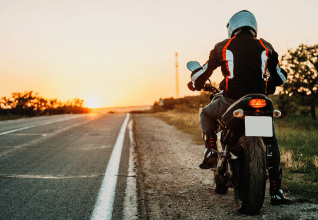Riding a motorcycle in Ireland can be an exhilarating experience but it also comes with its own unique challenges and responsibilities. Whether you’re a veteran motorcyclist or just starting out, understanding motorcycle safety is crucial for staying safe.
This guide, part of the Irish Road Safety Week 2024 campaign, covers everything you need to know to stay safe on the roads.
Importance of Motorcycle Safety
Motorcycle safety isn’t just about following the law—it’s about protecting your life and ensuring enjoyable rides every time you hit the road.
Why Motorcycle Safety Matters:
- Vulnerability: Motorcyclists are more exposed and susceptible to injuries in accidents.
- Visibility: Being visible to other drivers reduces the risk of collisions.
- Control: Proper handling and awareness can prevent accidents and enhance your riding experience.
Laws for Motorcyclists in Ireland

Ireland has specific laws designed to ensure motorcycle safety. Knowing and adhering to these regulations is essential for all riders.
Key Points:
- Licensing: Ensure you have the correct motorcycle licence for your bike’s engine size.
- Helmet Use: Wearing an approved helmet is mandatory for all riders and passengers.
- Protective Gear: While not always legally required, wearing protective clothing like jackets, gloves, and boots is highly recommended.
- Insurance: Every motorcycle must be insured according to Irish law.
- Road Rules: Obey all traffic signals, speed limits, and road signs to avoid fines and penalties.
Understanding and following these laws not only keeps you safe but also helps you avoid legal troubles.
Types of Motorcycles and Safety Gear
Choosing the right motorcycle and safety gear is fundamental to a safe riding experience.
Common Types of Motorcycles:
- Standard Bikes: Versatile and suitable for various riding conditions.
- Sport Bikes: Designed for speed and agility, ideal for experienced riders.
- Cruisers: Comfortable for long-distance rides with a relaxed riding position.
- Dual-Sport Bikes: Suitable for both on-road and off-road riding.
Essential Safety Gear:
- Helmet: Always wear a certified helmet that fits properly.
- Jackets and Pants: Protective clothing with padding to guard against impacts.
- Gloves: Protect your hands from the elements and injuries.
- Boots: Sturdy footwear to protect your feet and ankles.
- Eye Protection: Goggles or visor to shield your eyes from debris and wind.
Investing in quality gear can significantly reduce the risk of injuries and enhance your riding comfort.
Riding Techniques for Safety
Mastering safe riding techniques can make a huge difference in preventing accidents and ensuring smooth rides.
Essential Techniques:
- Stay Visible: Use bright and reflective gear, and keep your headlights on.
- Maintain Distance: Keep a safe distance from other vehicles to allow ample reaction time.
- Use Signals: Always indicate your turns and lane changes clearly.
- Scan the Road: Continuously look ahead and be aware of your surroundings.
- Brake Smoothly: Apply brakes gradually to avoid skidding and maintain control.
Practising these techniques helps you navigate traffic safely and respond effectively to unexpected situations.
Motorcycle Maintenance
Regular maintenance keeps your motorcycle in top condition, ensuring it performs safely on the road.
Maintenance Tips:
- Check Tyres: Ensure proper tread depth and correct tyre pressure.
- Brake Inspection: Regularly check brake pads and fluid levels.
- Oil Changes: Follow the manufacturer’s schedule for oil replacements.
- Lights and Signals: Ensure all lights and indicators are functioning correctly.
- Chain and Sprockets: Keep the chain lubricated and check for wear regularly.
A well-maintained motorcycle is less likely to experience mechanical failures that can lead to accidents.
Training and Licensing
Proper training and licensing are vital for safe motorcycle riding. They equip you with the skills and knowledge needed to handle your bike confidently.
Training Essentials:
- Initial Basic Training: Mandatory training course that covers fundamental riding skills and safety practices.
- Advanced Courses: Focus on handling emergencies, night riding, and adverse conditions.
- Licence Progression: Start with a provisional licence and progress to a full licence as you gain experience.
Investing time in training enhances your riding abilities and boosts your confidence on the road.
Riding in Various Weather Conditions
Ireland’s unpredictable weather requires riders to adapt their riding style to stay safe in different conditions.
Weather-Specific Tips:
- Rain: When driving in rain Reduce speed, increase following distance, and avoid sudden manoeuvres.
- Fog: Use low beam headlights, wear reflective gear, and ride cautiously.
- Wind: Stay balanced and be prepared for gusts that can affect your control.
- Cold Weather: Wear layered clothing to stay warm and maintain flexibility.
Adapting your riding techniques to the weather ensures you remain in control and visible, no matter the conditions.
Sharing the Road with Other Vehicles
Navigating shared roads requires awareness and courtesy to ensure safety for all road users.
Key Practices:
- Respect Lane Discipline: Stick to your lane and avoid weaving between traffic.
- Use Mirrors: Regularly check your mirrors to stay aware of surrounding vehicles.
- Communicate: Use hand signals and verbal cues to communicate with other drivers.
- Anticipate Actions: Predict the movements of other road users to avoid collisions.
- Be Courteous: Respect other drivers and cyclists by sharing the road responsibly.
Building good road habits fosters a safer environment for everyone sharing the road.
For reliable and trusted car insurance, contact KennCo on 01 409 2600 today, or visit our website for a fast, secure online quote.

Written by KennCo Staff
Approved by Marketing Manager Noel Gavin
